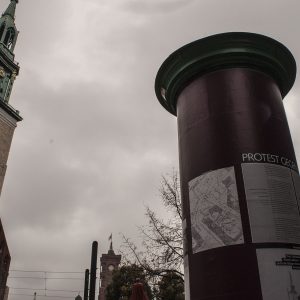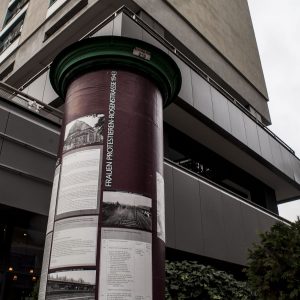In 1943, a protest by a large group of German women astounded the Nazi authorities and lead to the release of thousands of Jewish prisoners. Today, the Block of Women memorial marks the spot of the rebellion.
Berlin’s Block of Women is a monument on Rosenstrasse in the German capital. Rosenstrasse runs between Hackescher Markt, home of the Anne Frank Centre, and Alexanderplatz. The street marks the boundary of one side of a small park, where a group of women staged a protest on the site of an old synagogue destroyed in the Second World War.
By the end of February 1943, the SS and Gestapo detained around 8,000 Jewish citizens in Berlin. This number included approximately 2,000 Jews who were partners in mixed marriages. Until then, mixed marriages had been more tolerated. In 1943, authorities separated them from the rest of the prisoners. They held them in the building that once held the Jewish Welfare Administration at 2-4 Rosenstrasse.
Many of these prisoners were men and unsure of the fate of their fathers, sons, and brothers, a large group of non-Jewish women gathered. The date was 27th February 1943 and the women demanded to speak with their loved ones and requested their release. For a week, over 600 women protested daily in Rosenstrasse.
The women refused to leave until the Nazi authorities released the men of the families. On the first night, a Jeep carrying four men from 1st Waffen SS Division Adolf Hitler Leibstandarte drove up and told the women to go home. They refused. This act of rebellion astonished the Nazis. SS guards called for the Berlin police for reinforcements as the protesting crowds grew.
Protests stopped only once on the night of 1st March 1943 as the Royal Air Force bombed the city. That date was a national holiday in Germany honouring the Luftwaffe founded on 1st March 1935. The prisoners at Rosenstrasse observed cowardice from the SS and Gestapo who were the first to run for cover when the bombing began.
Authorities expected the protests to stop after the bombing. To their surprise, the protesting crowds of women grew larger. Alfred Schneider, the SS commander in charge of Rosenstrasse appeared outside the building. He commanded the women to go home and again they refused. The SS aimed guns at the women telling them to clear the streets but no shots came forth.
The Nazis knew that German morale could suffer if they murdered hundreds of unarmed women in the streets of Berlin. On 5th March 1943, trucks laden with machine guns arrived in Rosenstrasse but again the women would not back down. The following night, Joseph Goebbels ordered the release of all the men in 2-4 Rosenstrasse. News soon spread throughout the Allied nations despite Goebbels claim that the women had protested the RAF bombing.
The protest by these women of Berlin was peaceful and none of those responsible received any punishment.
Since 1995, in the Block of Women, a sculpture by Ingeborg Hunzinger commemorates these courageous women. It also stands as a reminder of discrimination and ethnic persecution, which should never happen again. Work began on the piece in the mid-1980s.
An inscription reads:
The strength of civil disobedience, the vigour of love overcomes the violence of dictatorship. Give us our men back. Women were standing here, defeating death. Jewish men were free.
Six elements make up the monument. Three red sandstone blocks carved with Jewish characters, texts, and symbols form a semi-circle around a couple. The couple lie in each others’ arms. Two of the blocks appear torn apart. From one block, a man looks out across to a woman on the other block. Other figures show desperation and fear but also the unity and strength of the Jewish people.
Other elements include a man holding a broken violin depicting the destruction of Jewish culture. There is also a figure seated on a park bench, an activity forbidden to Jews at the time.
The Block of Women monument in a small Berlin park marks a momentous time in history. It was unheard of for the Nazi regime to give into the pressure of protest and the gathering of German women as a united voice again oppression was unprecedented.




